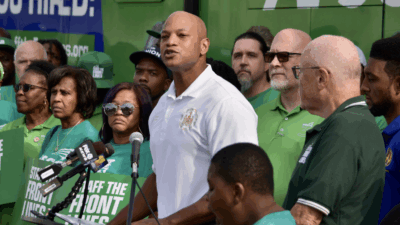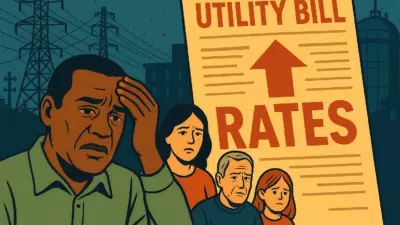Thousands of state employees were recently notified by email of a buyout program, part of a plan by Democratic Gov. Wes Moore to reduce the size of state government and cut $121 million from ongoing personnel expenses.

Details of the “voluntary separation program” were also posted on the website of the state Department of Budget and Management. The plan, first announced in late June, offers eligible, full-time employees in the executive branch $20,000, plus an additional $300 for each year of service. It will also cover six months of paid state health benefits and pay out unused leave and compensatory time.
There is no target for the number of employees the state is hoping will take the buyout, officials said.
“The VSP is one of several actions the governor has implemented to achieve the $121 million reduction, including the hiring freeze already announced,” a spokesperson for the Department of Budget and Management said in an email last week.
There are nearly 52,000 positions within the state personnel and Maryland Department of Transportation personnel systems. About 4,800 were vacant as of May, the spokesperson said, and 13,500 are in job classifications that are exempt from the buyout offer.
Not all of the remaining workers will be eligible, because some have less than two years of service, and not every employee who applies will be approved.
“It is up to the agency and ultimately the secretary of Budget and Management to approve or deny an employee’s application,” the department spokesperson said.
The deadline to apply is 11:59 p.m. on Aug. 4.
Maryland Republican leaders speak out
GOP Senate Minority Leader Sen. Stephen S. Hershey Jr. called the offer a “short-term fix for a long-term problem” created by Moore and the Democrat-controlled legislature.
“This program likely won’t do enough,” Hershey said in a statement. “The incentive is too small to prompt meaningful participation from higher-paid employees — the very group whose departure would deliver the most savings.”
Hershey said the $20,000 payout “is barely two months’ salary” in many cases. He warned of what he said would be additional efforts to raise taxes in the legislative session that beings in January.
“Unless Governor Moore is ready to truly reverse course — by scaling back the size and scope of government, embracing fiscal discipline, and respecting bipartisan ideas — Marylanders should brace for more service cuts, more workforce reductions, or yet another round of tax hikes,” Hershey’s statement said.
Nearly three dozen agencies are excluded from the offer. Another nearly 1,700 job classifications are also ineligible.
Employees who submitted a resignation prior to July 10 are ineligible, even if they rescind their original decision.
Other ineligible workers include:
- Those who have applied for service or disability retirement that are either under consideration or approved.
- Terminated employees or those that receive notice of termination by Sept. 30.
- Employees who transfer to another state job between July 10 and Sept. 30.
- Employees who leave their state jobs before Sept. 30.
Officials in the Moore administration previously said the legislature, as part of the budget passed earlier this year, requires them to cut $121 million in ongoing expenses from the current year’s general fund budget.
The governor’s office laid out a plan in broad strokes late last month that includes eliminating 150 vacant positions and imposing a hiring freeze. The plan also called for buyouts. The administration has been reluctant to make public any exact targets.
Early conversations about the budget reductions included requiring as much as a 6% budget reduction from most departments and agencies, which could have been achieved through office space consolidation and other efficiencies, as well as personnel moves. Those same conversations included the possibility of voluntary buyouts and job reductions through attrition and even layoffs in some cases.
Legislators, however, differed with Moore on exactly what the budget reduction goal required — specifically the need to lay off employees.
Officials with the American Federation of State, County and Municipal Employees Council 3 — which represents more than 26,000 state employees — also staunchly opposed proposals that include laying off employees.
In a recently issued statement, union officials reiterated their opposition to layoffs.
“Any solutions to help our state navigate these tough and volatile times must not come at the cost of providing quality state services,” the union staetment said.
Several agencies — the so-called 24/7 agencies that include state hospitals, the departments of Juvenile Services and the Public Safety and Correctional Services — already suffer from high numbers of vacancies that are covered with overtime.
Union leaders said they worry those understaffed agencies are already at risk for dangerous working conditions and workloads that are unsustainable.
“We want to reiterate that responsible decision-making around both cost-saving and revenue-raising measures must prioritize preserving our state services and the jobs of the workers who make them happen,” the union said. “That includes eliminating costly contracts, in-sourcing services where needed, addressing other inefficiencies, and closing corporate tax loopholes to raise much-needed state revenues.”
The effort to reduce the size of the workforce is a reversal of Moore’s promise to reduce the number of state vacancies. He entered the governor’s office in January 2023 vowing to “rebuild state government.”
At the time, he estimated there were 10,000 vacancies — a number that included the executive branch, higher education and other positions. He publicly committed to cutting that number in half in his first year in office.
At the same time, he also expanded the number of state jobs and raised salaries.







